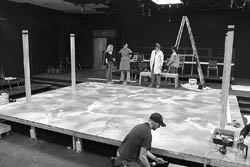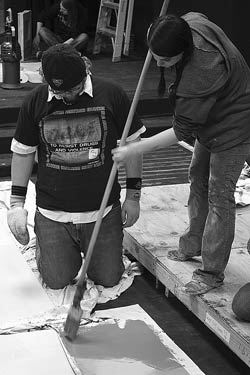|
A&E |
|
Antigone set design takes a page out of Greek theater playbook
The Advocate
When designing the set for the spring production of “Antigone,” Daryl Harrison-Carson, theater technical director, found it was more about what she didn’t want the set to convey.
“The set can’t convey too much or it’ll get in the way,” Harrison-Carson said of the play set to open April 29 at 8 p.m.
|
||||
Harrison-Carson focused on creating “an open place that can be anywhere. There’s no time period. We didn’t set it in ancient Greece.”
The set is centered on a platform, taking inspiration from MHCC’s Main Mall.
“It was a discussion Rick (Zimmer, theater director) and I had last spring,” Harrison-Carson said.
Zimmer said of the Main Mall, “I saw the circles surrounded by the light posts and thought immediately of Greek theater.”
Zimmer also said he thought about moving the production outside, but said he chose a different route because the actors would have been forced to use microphones.
|
||||
Instead, the set was moved to the Studio Theater, still with its Main Mall-inspiration, with the platform resembling marble. Aside from the historical context, Harrison-Carson said the marble represents more than architecture.
Harrison-Carson compared the set to Antigone herself, saying, “(It’s) this really solid thing that should be permanent, but it’s cracked and bleeding.”
“She was doomed from the beginning,” Harrison-Carson said.
Another aspect of the set is that audience seating will surround the platform, a technique called theater-in-the-round.
“We haven’t run into any trouble,” Harrison-Carson said of constructing the set, adding that the “main limitation is time. We have to work very quickly,” but that “everyone’s working diligently.”
“The set has to be configured so that you can aim light at the people (on stage) without blinding the audience,” Harrison-Carson said. Jamie Bradley, the electrician for the production, added, “We run out of lights really quickly. There’s not a lot of room for anything special.”
According to Zimmer, the traditional blocking styles also were modified to accompany the arena-style seating.
“The very first thing is the actors writing down movements,” Zimmer said. In traditional blocking, there is upstage and downstage; however, “In-the-round it’s all 360 degrees.” Zimmer had the actors establish their blocking “based on where in the clock dial they were.”
“We actually did it once before with Company of Wayward Saints,” Harrison-Carson said. She added that the comedy is much different from “Antigone.” The set consisted of a wagon that came apart and was “an engineering feat,” according to Harrison-Carson.
She said construction for “Antigone” was going smoothly. “I’d like to see the rest of it completed by the middle of next week, by April 22.” She said she would still “knock on wood.”
Until then, Harrison-Carson focuses on constructing a set that doesn’t give way to any specific place or time.
“With Greek theater, you can decide it doesn’t relate to you because it took place so long ago,” Harrison-Carson said. “The audience can focus more on the relationships of the characters instead of focusing on where they are and what time period they are in.”


